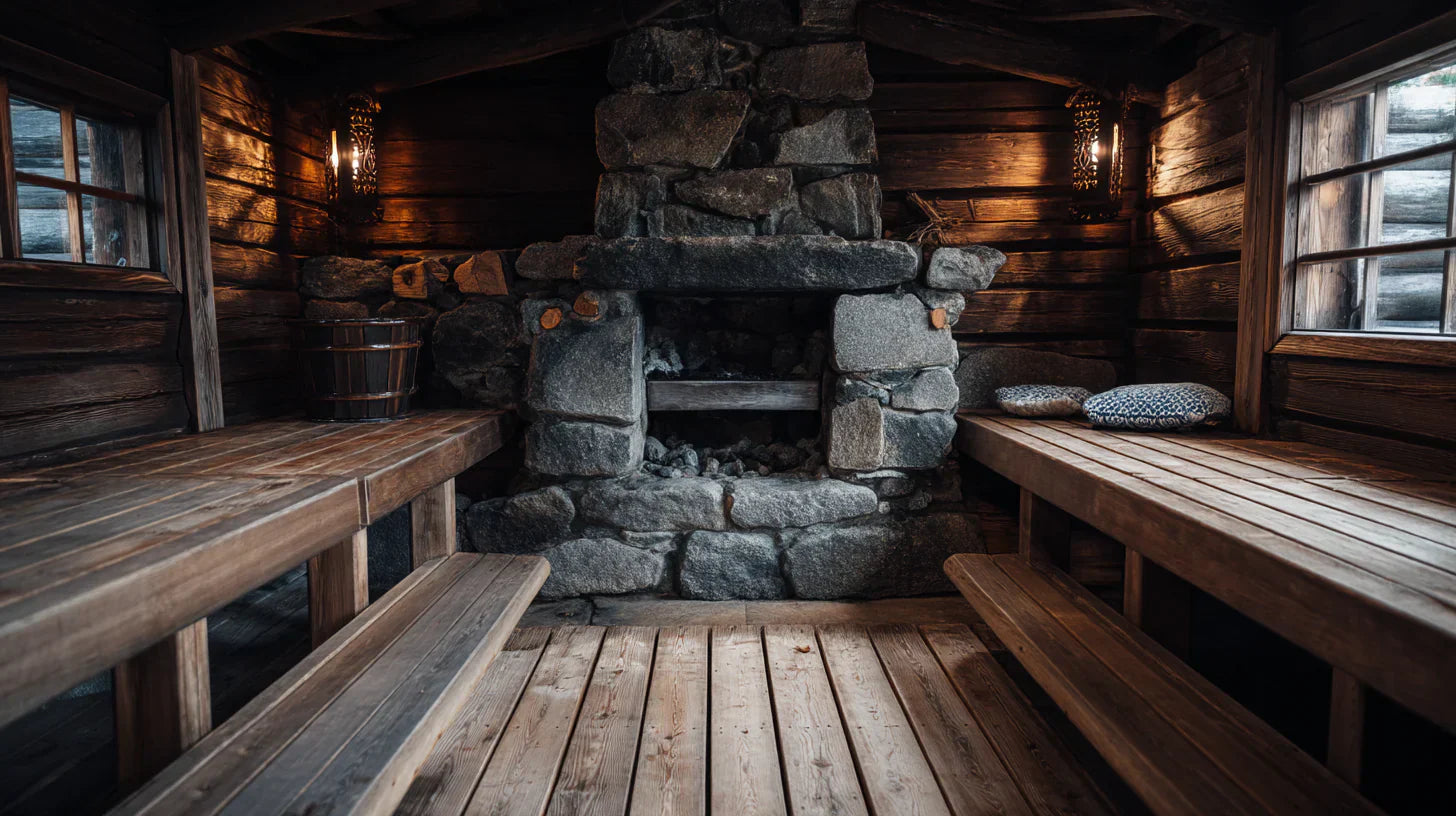What Are Sauna Rocks and Why Do They Matter?
Sauna rocks also called sauna stones are essential to a genuine sauna experience, especially in a traditional Finnish sauna setting. These quality sauna stones work together with the sauna heater to retain heat, creating the steam generation that defines sauna culture. In wood‑burning or electric sauna stove setups, sauna stones are what allow water to sizzle into steam when poured, creating the sensation known as löyly. Without the right stones, heat retention is poor, steam generation is inconsistent, and the overall sauna experience is diminished.
Sauna stones are not decorative stones or rounded stones for aesthetics, they are serious functional components, chosen stones that ensure high heat capacity, withstand high temperatures and rapid temperature changes, and deliver consistent heat. They are often volcanic rocks or igneous rocks such as basalt, olivine diabase, red granite or other minerals. These stones must be dense, durable, and capable of withstanding stress and thermal shock. In portable or full‑size sauna use, sauna stones retain heat to create a steady thermal environment inside the sauna room, giving users multiple sauna sessions of high temperature without constant reheating.
The Science Behind Heat Retention and Steam Generation

Why Quality Sauna Stones Are Different from Decorative or Ordinary Stones
Choosing sauna stones is not a question of personal preference for style, but rather of key properties like density, heat retention, porosity and resilience to extreme temperatures. Regular decorative stones or rounded stones are often cheap granite or river stones that may shatter or break when subjected to rapid temperature changes, throwing risk into the sauna experience.
High density stones such as red granite, basalt, or specifically igneous rocks like olivine diabase or gabro are a reliable choice. These volcanic rocks have mineral deposits that allow them to absorb and release heat smoothly. When water is poured over high heat stones, room temperature water instantly vaporizes into steam, boosting humidity and heat inside the sauna room without raising air temperature. That is how the sauna heater and stones work in harmony to create an exhilarating experience.
Ineffective stones cannot withstand rapid temperature changes or maintain heat retention through multiple rounds. They may crack or break apart, reducing safety and undermining the ritual of the sauna session. A quality sauna stone set holds consistently high temperatures, withstands thermal stress, and yields vibrant steam generation with each ladle of water.
How Sauna Stones Work in a Sauna Heater or Stove
In a wood‑burning sauna stove the heating elements are the fire and the stones stacked above them. In an electric sauna stove the heating element is an electric coil but equally the sauna stones must absorb heat and radiate steam. The combination of the heater and chosen stones creates the thermal mass that ensures consistent heat, high heat capacity and smooth steam generation.
As the electric sauna warms the stones up, once they exceed approximately 200°F, they are capable of instant steam generation when water is poured. These chosen stones act as a thermal battery. They absorb the energy from the heater then radiate it into the air. This retained heat can be released evenly over hours, allowing multiple sauna sessions without repeated reheating. This is how quality sauna stones enhance the functionality of any sauna stove.
If sauna stones are too smooth, they may not create sufficient surface area for evaporation. Natural rough surfaces, like those on igneous volcanic rocks such as basalt or olivine diabase, maximize steam when cold water is applied. This creates a deep, humid heat that defines an authentic Finnish sauna experience.
Choosing Sauna Stones: Key Properties and Types
What Makes a Sauna Stone Sauna‑Grade?
There are several key properties to consider when choosing sauna stones:
-
High Density — Stones must be tightly packed, resistant to thermal shock, and capable of heat retention.
-
Surface Area — Rough porous surface allows efficient steam generation.
-
Mineral Composition — Prefer igneous rocks such as so-called basalt, olivine diabase, red granite or gabro. Other minerals like peridotite are also used.
-
Durability — Stones must withstand high temperatures repeatedly and endure stress from temperature cycling.
-
Heat Capacity — Stones need enough mass to accumulate energy and radiate it back during sauna use.
When stones meet those criteria they will consistently retain heat and resist cracking during rapid temperature changes. A sauna use routine with improper stones will result in reduced steam generation, uneven temperature, and poor performance.
Examples of Sauna Stone Types
-
Olivine Diabase — Excellent heat capacity, volcanic, high density, can withstand extreme temperatures.
-
Basalt — Natural volcanic rock, durable, reliable choice for consistent heat and steam.
-
Red Granite — Igneous with mineral deposits that hold heat well but may cost more.
-
Rounded Stones or Decorative Stones — Avoid these unless explicitly rated sauna stones, because smooth surfaces reduce evaporation efficiency and heat retention.
Each stone type offers unique properties. Olivine diabase and basalt are often preferred because they combine high density, thermal stability, and a rough texture ideal for steam generation.
Preparing, Using and Maintaining Sauna Stones

Preheating and Break‑In Procedures
Before first usage, sauna stones should be preheated slowly within the sauna stove. If your set includes raw stones, rinse with cold water to remove dust, then allow the heater to warm them gradually. This break‑in method reduces the chance of cracking due to mineral layering or trapped moisture within the igneous rock. Preheating also improves heat retention over time.
Arranging Stones for Steam and Airflow
Proper arrangement of sauna stones in the sauna stove or heater is essential. Do not crowd the stones tightly. Leave air gaps for good ventilation. Place larger stones at the bottom and smaller at the top to promote even heating. Stacking stones loosely ensures consistent heat generation and avoids cold spots. That arrangement allows the heating elements to work efficiently and ensures robust steam with each pour of cold water.
Pouring Water and Steam Generation
When pouring room temperature water or cold water over heated stones, do it slowly, little water at a time, to avoid cracking the stones and to generate controlled bursts of steam. If you throw too much water at once, stress on the stones increases and steam can become uncomfortable or unsafe. Small amounts of water create moderate humidity and help to maintain extreme temperatures in balance. The sudden evaporation as the water hits hot stones is what creates the authentic steam sensation central to sauna culture.
Cleaning and Replacing Stones
After heavy sauna use or at seasonal intervals, rinse stones to remove mineral deposits that may accumulate from water. Inspect stones periodically for cracking or crumbling. If steam generation falls off or stones break apart, replace them. Quality sauna stones last 1‑2 years depending on frequency and intensity of sauna use. Dispose of old stones responsibly by reusing them in landscaping or returning them to nature.
Enhancing the Sauna Experience with Proper Stones
Sauna Culture, Finnish Sauna Rituals and Löyly
In true Finnish sauna culture löyly is the spirit of steam. When water touches sauna stones the heat waves move around the sauna room, increasing humidity and comfort without raising air temperature excessively. Many people think pouring more water equals more steam, but actually the balance of little water at a time, consistent heat and the right stones create the most satisfying wave of steam. Too much water can overwhelm the stones and disrupt temperature consistency.
Sauna stones that correctly retain heat while allowing evaporation help maintain a stable environment, letting users enjoy repeated sauna sessions with intensity, warmth and community. The overall sauna experience depends as much on the stones as on the heater or stove.
Essential Oils, Aromatics and Steam
Enhance the session by adding essential oils diluted in water. Pour a small amount over the stones for fragrant steam. Popular options include eucalyptus for invigorating freshness, lavender for relaxation, pine or cedar for earthy aromas that evoke forest air. Always dilute oils properly and pour carefully over stones after testing their temperature. This improves sauna use enjoyment without affecting the performance of the stones or heater.
Safety Tips: Preventing Stress and Stone Failure

Avoid Common Mistakes
Never use stones that are not sauna‑grade. River rocks, decorative stones or rounded stones meant for landscaping can explode or crack when exposed to high temperatures. Use only stones designed intentionally for sauna heater use.
Always wear gloves when handling hot stones or adjusting them near the sauna stove. Use room temperature water or cold water carefully, little at a time, to prevent thermal shock.
Ensure good ventilation inside the sauna room so air can circulate freely around the stones and heater. Good ventilation helps with temperature regulation, consistent heat and safe steam generation.
Storage and Weather Protection
When not in use, keep sauna stones in a dry location. Exposure to rain or humidity can trap moisture in the stones. If reheated stone holds water, it may crack under stress. Before winter storage, remove stones, dry them, and store in a breathable container. That ensures they retain their high heat capacity and will perform properly in the next sauna session.
Frequently Asked Sauna Stones and Sauna Experience Questions
Can I Use Rounded Stones or Decorative Stones?
No. Rounded stones or decorative stones are typically too smooth and may retain moisture. They will not retain heat efficiently and may crack during rapid temperature changes. Only choose sauna stones rated for high heat capacity and sauna use.
How Often Should I Replace Sauna Stones?
Every 12 to 24 months depending on frequency of sauna sessions and intensity of heat exposure. Replace sooner if stones crack, crumble or show reduced steam generation.
Can Sauna Stones Explode?
Yes, if they contain moisture or are not sauna‑grade. Stones not designed to withstand high temperatures may fracture violently under thermal stress. Always use igneous volcanic rocks designed for sauna heater use.
Are Sauna Stones for Electric Sauna Different?
Electric sauna stoves and wood‑burning sauna stoves both rely on sauna stones for steam generation. In electric sauna, stones rarely exceed 160°F, but in wood‑burning sauna they often exceed 200°F. That means stones must withstand higher temperatures and rapid changes when water hits them.
Should I Clean Sauna Stones?
Yes, rinse before first use and periodically rinse after heavy usage to remove mineral deposits. But do not overclean. A quick rinse is sufficient. Heavy cleaning may reduce surface roughness and impair steam generation.
What Are the Best Sauna Stone Types?
Olivine diabase, basalt, red granite, gabro and volcanic rocks are top picks. They combine density, heat capacity, porosity, and durability. Jade stones are sometimes marketed but rarely ideal unless properly tested. Best to choose stones explicitly labeled quality sauna stones.
Why Quality Sauna Stones Transform the Sauna Room and Heater Performance
When correctly chosen, installed and maintained, sauna stones can dramatically elevate your sauna experience. They allow the heater to function efficiently, retain heat longer, and produce deep, penetrating steam. The synergy of high heat capacity stones and proper sauna stove alignment ensures consistent heat, resilient performance under extreme temperatures, and a communal sauna ritual rooted in Finnish sauna culture.
Using quality sauna stones in your sauna heater makes a huge difference in steam generation, humidity balance, and participant comfort. The right stones work with the heater not simply as a heat source but as a partner in performance.
Final Thoughts: Elevating the Sauna Experience One Stone at a Time
Sauna stones are far more than inert decorative elements. They are at the core of steam generation, heat retention, and the sauna culture that people cherish across generations. Whether you use an electric sauna stove or wood‑burning sauna heater, the quality and type of stones you choose define how well your sauna sessions perform, especially under extreme temperatures.
Only igneous volcanic rocks such as basalt, olivine diabase or red granite possess the heat retention and durability required. When you pour cold water slowly over hot stones with sufficient surface area and even temperature, each experience becomes an exhilarating moment of löyly.
Investing in and caring for quality sauna stones ensures consistent heat, rich steam, reliable performance, and continuous connection to tradition. In every sauna room, every session, every drop of water poured, those stones tell the story of real heat, real ritual, and real sauna.
Ready to transform your sauna experience with the right stones and heater support? Explore our curated collection of quality sauna stones, compatible stoves and expert setup guides to embrace full sauna culture with confidence.



How Long Can You Stay in a Portable Sauna: A Guide to Sauna Therapy and Health Benefits
Do You Need a Permit for a Portable Sauna? A Detailed Guide to Permitting Outdoor Saunas